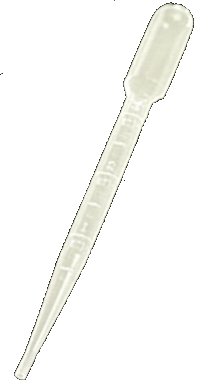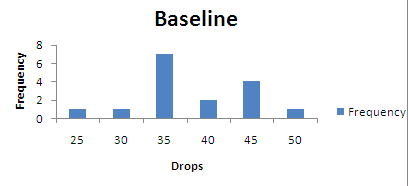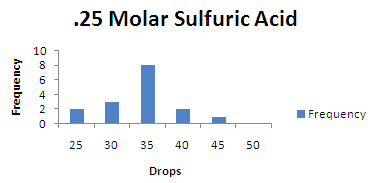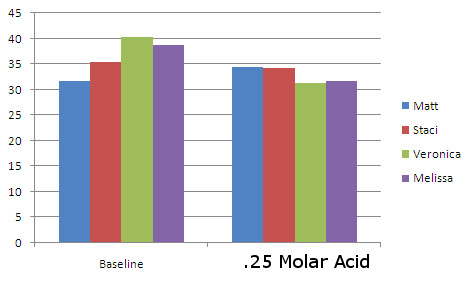Properties of Water: Penny Lab
From ThePlaz.com
Testing the effect of Acid on the ability of water to remain on a penny for Biology by Matt, Staci, Veronica, Melissa, and Michael
Contents |
Hypothesis by Staci
Acid will lower the cohesion in water causing less drops of water to fit on a penny. Many drops of water may remain on the penny because of the cohesive property of water.
Procedure by Matt
- First the testing group retrieved a water sample with a pH of 7
- That sample was then used to set a baseline for the number of drops that could be placed on the penny before the bubble burst using the following steps:
- the penny was cleaned and dried
- drops of water were placed on the penny using a pipette
- these drops were counted until the water spilled over the side of the penny
- the final number of drops was recorded
- this was repeated by each member four times
- The water was replaced by the experimental solution: .25 molar sulfuric acid mixture with a pH of 2
- The trials were repeated with the experimental solution
- the penny was cleaned and dried
- drops of the solution were placed on the penny using a pipette
- these drops were counted until the water spilled over the side of the penny
- the final number of drops was recorded
- this was repeated by each member four times
Data by Michael Plasmeier
Baseline
Drops of tap water (pH 7) were placed on a penny until the surface tension broke and the water spilled off of the penny. Water was dropped onto the penny from a pipette suspended a few millimeters from the top of the water.
| Matt |
Plaz |
Staci |
Veronica |
Melissa |
| 31 |
34 |
42 |
25 | |
| 29 |
35 |
45 |
38 | |
| 35 |
31 |
34 |
42 | |
| 32 |
42 |
40 |
50 | |
| 31.75 |
35.5 |
40.25 |
38.75 |
| St dev | 6.562202 |
| Mean | 36.5625 |
| Median | 35 |
| Mode | 42 |
Experiment
Water was replaced with the .25 molar sulfuric acid mixture with a pH of 2
| Matt |
Plaz |
Staci |
Veronica |
Melissa |
| 35 |
34 |
37 |
25 |
32 |
| 34 |
35 |
35 |
28 | |
| 27 |
35 |
37 |
35 | |
| 42 |
30 |
25 |
32 | |
| 34.5 |
34.25 |
31.25 |
31.75 |
| St dev | 4.711688 |
| Mean | 32.75 |
| Median | 34.5 |
| Mode | 35 |
Results by Melissa
There was a 3.8125 drop decrease due to .25 molar sulfuric acid mixture with a pH of 2. This is a 10.4% decrease from the baseline.
The experiment show that the acidic water decreases the amount of drops which can fit on a penny before the water's surface tension is broken.
Two out of four of the testers had relatively large decreases while the other two had small changes. One of the testers saw an increase in the number of drops which could fit on the penny. This may be because each tester dropped water onto pennies in different ways, such as applying different amounts of
pressure on their pipette and dropping water from different heights above the penny. In addition there might have been minor variation in the pipettes and pennies, producing different numbers of drops it takes
before the penny's surface tension was broken.Analysis by Veronica
The experiment shows the difference in cohesion to a penny between a neutral and acidic solution. The water had a pH level of 7 and the .25 molar sulfuric acid had a pH level of 2. The hypothesis was confirmed, acid reduced the number of drops that could be added to the surface of a penny by 10.4%.
Furthering testing into the effects of pH level on the number of drops of water which can fit on a penny could be done. Increasing the concentration of the sulfuric acid might further decrease the cohesion to the penny; while decreasing the concentration might increase the cohesion of water on the penny. Further experiments could be done into the effects of basic solutions onto the cohesion of water.
Atmospheric conditions including humidity could also affect the cohesion of the liquid on the penny. If there is more water in the air that might change the size of the drops coming out of the pipette or the cohesion of water. Temperature can also affect the cohesion of the solution. Obviously, the water would have to be above the freezing point and below the boiling point of the solution in order for the solution to form drops. However while the solution is a liquid, how does temperature affect the cohesion of water on the penny?






